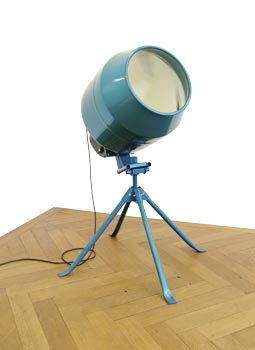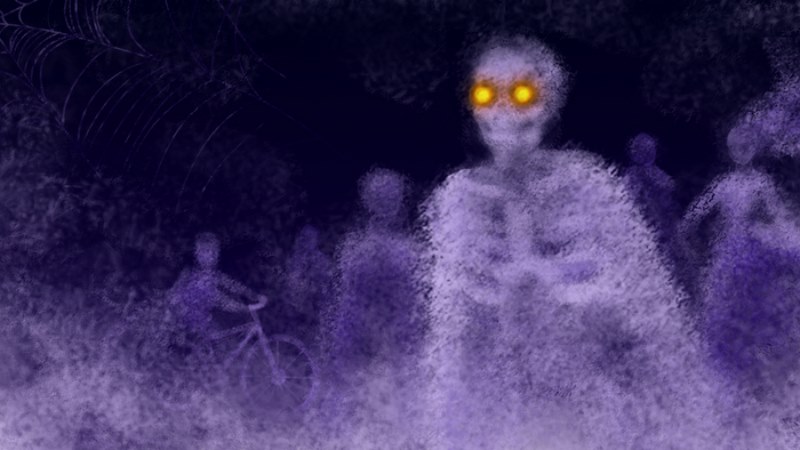At the end of late March, while I was in Frankfurt inaugurating an exhibition, I decided to take a short break to visit Anita Beckers, friend and gallery owner. So I owe her then my first contact with the work of Blue Curry. After that doubly happy encounter with Anita and Blue Curry, came to my mind a number of questions whose answers I tried in vain to decipher reaching for the well-worn topics of the "center" and the "periphery".
Let’s see. Blue Curry is a young Caribbean artist from Nassau, Bahamas. Despite the strange European fascination-projection regarding the Caribbean, even today it can be counted with the fingers the artists from that "peripheral" region whose work has had a real impact on the art centers in this part of the West. Apparently, the prevailing trend so far in the cycle of recognition of a Caribbean artist in Europe, and I don’t want to make from this an axiom, it has been to establish himself in the U.S. market and later get the recognition of the academy of that country. Once filtered in that way, the possibility of a triumphant rebound in Europe is almost guaranteed. The most emblematic case that always comes to mind is that of Wifredo Lam. He made his art career among the French surrealists and he spent half of his life in France, however, it was MoMA the first major museum who recognized the artistic value of his work.
 But let’s go back to Blue Curry. Who is this young emerging artist who is receiving increasing attention in the European art centers? A brief review of its educational biography tells us that in 2004 he earned a BA (Bachelor of Arts) in Photography and Multimedia from Westminster University, and in 2009 he completed his master’s degree in Fine Arts at Goldsmiths College, London. The Art Department at this latter university is one of the most prestigious in England; according to Wikipedia, over twenty awards Turner and members of the Young British Artist Collective (Tracey Emin, Sam Taylor-Wood, Jake and Dinos Chapman, Damien Hirst et alibi) come from there. But that's not all. In 2010 Blue Curry was included in the Catlin Guide along with the forty most important emerging artists in the UK.
But let’s go back to Blue Curry. Who is this young emerging artist who is receiving increasing attention in the European art centers? A brief review of its educational biography tells us that in 2004 he earned a BA (Bachelor of Arts) in Photography and Multimedia from Westminster University, and in 2009 he completed his master’s degree in Fine Arts at Goldsmiths College, London. The Art Department at this latter university is one of the most prestigious in England; according to Wikipedia, over twenty awards Turner and members of the Young British Artist Collective (Tracey Emin, Sam Taylor-Wood, Jake and Dinos Chapman, Damien Hirst et alibi) come from there. But that's not all. In 2010 Blue Curry was included in the Catlin Guide along with the forty most important emerging artists in the UK.
Despite having this bonus I his curriculum, the installation and sculptural work of this artist almost always refers us to the Caribbean context though, admittedly, without falling into the traps of tropicalism and ethnic discourse. Using materials such as shells or starfish, sand or sharks jaws, urchins, harpoons, buoys, coconuts and beans, at first sight, and I would like to note that only at first sight, they evoke a world that in Europe, especially , is built from an imaginary desire. From such a visual inventory many touristic fictions are feed, which find in catalogues and guides for vacationers their more allegorical specimens.
Unfortunately, if you are a Latin American or Caribbean artist in Europe they don’t even look at you with the vague suspicion of being the other, the intruder. They rather expect from you an alignment, a stance that reduces you, as a straitjacket, to the discolored limits of the political or the exotic.
When I think on this I cannot but subscribe what the Spanish philosopher Jose Luis Pardo suggested at the end of his Essay on the lack of business: "it would be good to abandon the pernicious idea that the art work must symbolize the truth (which often shows solidarity with an inhospitable world and an uninhabitable land) to experiment with another old idea of ??the art work: one that describes it as a symbol of freedom".
In many of the interviews made to Blue Curry there is always the obliged question about its strong dependence on exotic materials as if this is the essential feature of his artistic practice. It is true that he is negotiating all the time with these elements but he does it so from a position intentionally iconoclastic, almost neo-Dadaist. In his pieces all these elements associated with the Caribbean are always juxtaposed with other elements no precisely tropical, which generate a vague, imprecise connection, something that encourages us to look a little beyond the seen. In this way a double process of recycling is created, where the exhausted metaphor receives a new meaning.
That’s why is no wonder that Blue Curry himself declared in an interview that he hated "having to carry all the superficial associations of the touristic destination only because the Caribbean cannot be understood in terms of critical thinking or the contemporary art."
 To begin with, most of his work lack a title, thus, not conditioning the work to the marginality of the label, challenges the viewer to dive straight into it. So, far from provide an immediate response, forces him to deal hand to hand with that that Antonio Benítez Rojo called "a specialized machine in producing forks and paradoxes".
To begin with, most of his work lack a title, thus, not conditioning the work to the marginality of the label, challenges the viewer to dive straight into it. So, far from provide an immediate response, forces him to deal hand to hand with that that Antonio Benítez Rojo called "a specialized machine in producing forks and paradoxes".
We already learned that the paradoxes are half-truths that, by not revealing everything, always leave room for interpretation very prone to stimulate and disturb the minds. Let’s us consider, for example, the shark's jaw he hung from the ceiling in an exhibition in London and which, in turn, hung something like a long and thick dance costume consisting of 567 hours of cassette sound tapes; or the installation he made in 2006 in the Nassauischer Kunstverein of Wiesbaden, Germany, where he had two tons of sand to be carried from a beach in the Bahamas to fill a room with her.
One can imagine many things when one sees the shark's jaw open, or the room covered with a ton of sand or even a cement mixer beating 30 liters of sunscreen. If we look separately and linearly these components of Blue Curry’s narrative, we’ll arrive at conclusions which significance ends in the field of the trivial and escapist compensations that derive from the contemporary subject and that instrumental entelechy called welfare state.
However, there where the symbolic content of the "banal" materials that constitute the work of this artist are finished, is where his installation-sculpture system begins truly to operate. Let us return to the installation Like Taking Sand to the Beach, 2006. Here, through a rigorous process of taxonomy, like the romantic archaeological excavations of the late nineteenth, Blue Curry sliced a piece of beach, divided it into grids and extracted from each of them sandbags that he classified and ordered according to their size, weight and location in the marked area. In addition, over the excavated surface he put a sign with the inscription: "This segment of the beach is temporarily on loan to an international exhibition, sorry for the inconveniences." He then proceeded to pack and ship the sandbags to gallery in Germany where, meticulously following their placement order in the grids he reproduced exactly the same segment previously extracted from the Bahamian beach. After the exposure the sand was poured into their corresponding bags and deposited again its original place.
 I think there’s no need to be too expert in interpretation processes to realize the intent and meaning of an action that, in the eyes of everyone involved, was conducted according to a procedure of norms and parameters recognized, accepted and legitimized by knowledge that, assuming things, no one questions. Indeed, without having to impersonate an archaeologist, the artist appropriated and applied a convincing methodology, thus rectifying and giving logic shape, with the same procedures of the system, the absurd content of his work.
I think there’s no need to be too expert in interpretation processes to realize the intent and meaning of an action that, in the eyes of everyone involved, was conducted according to a procedure of norms and parameters recognized, accepted and legitimized by knowledge that, assuming things, no one questions. Indeed, without having to impersonate an archaeologist, the artist appropriated and applied a convincing methodology, thus rectifying and giving logic shape, with the same procedures of the system, the absurd content of his work.
The way I see it, in this kind of antinomian paradoxes, which seem to insinuate something but in practice they conceal their true intent, is where you can best measure the pulse of the work of an artist who is not interested in the de-"territorialization" of the map, but he does in the content. In his own words: "Contemporary art is silly at times, and I laugh about it intentionally. Only in art you could take a ton of sand on a vacation, fill a cement mixer with thirty gallons of sunscreen, or paste beans to a car tire and call it work. Having said all that, I'm still taking it seriously".
Publicaciones relacionadas

Obras de García Márquez para celebrar Halloween
Octubre 30, 2024
Cerrado por obras: Museo Sorolla
Octubre 29, 2024
La Mascarada llena de color y vida a Costa Rica
Octubre 28, 2024















